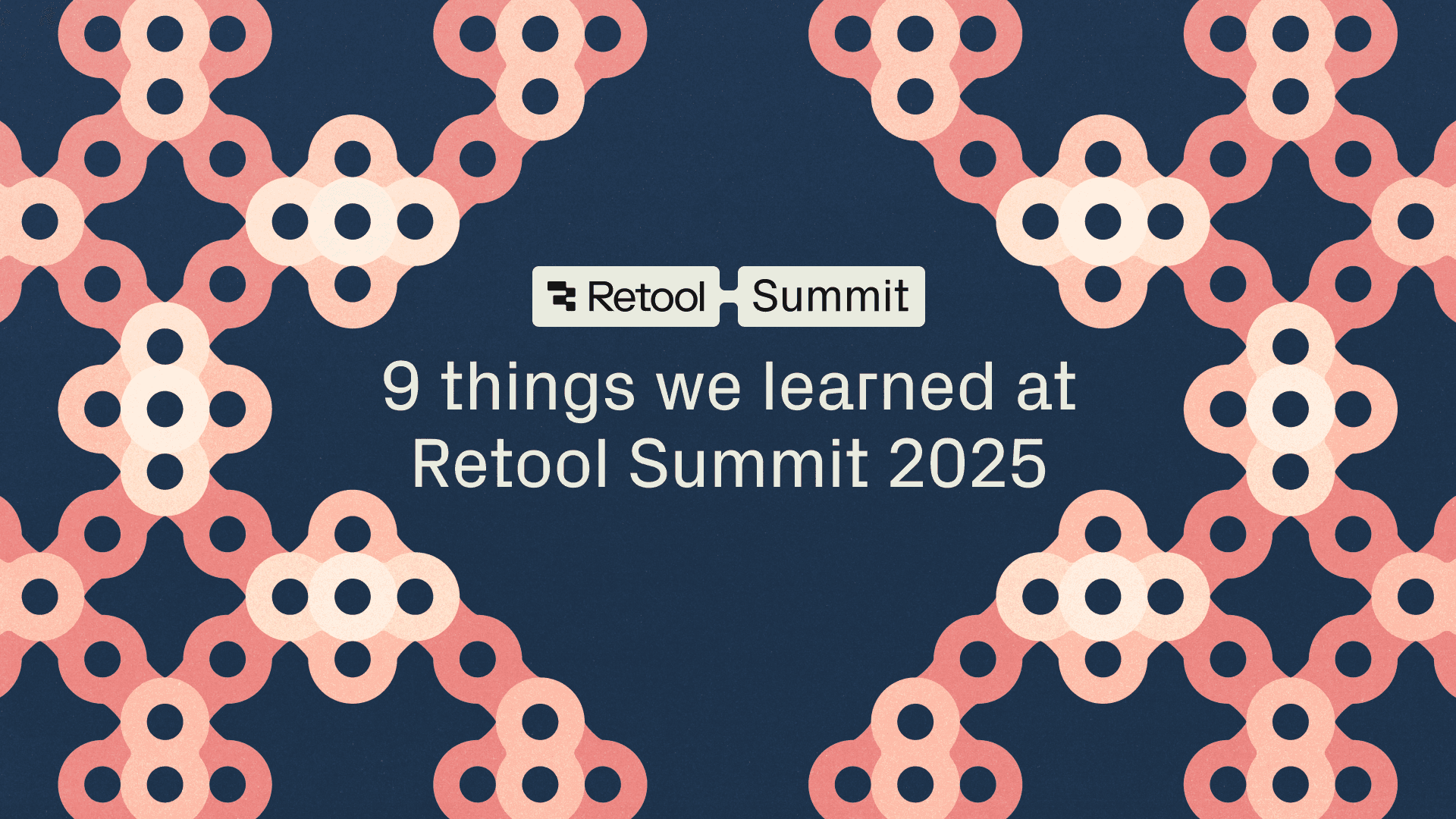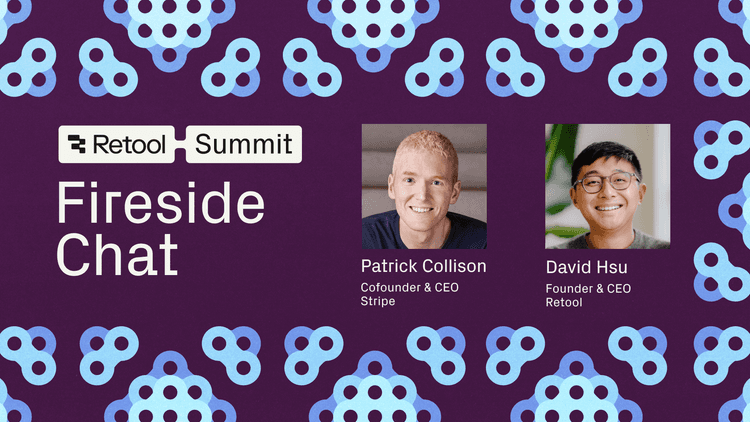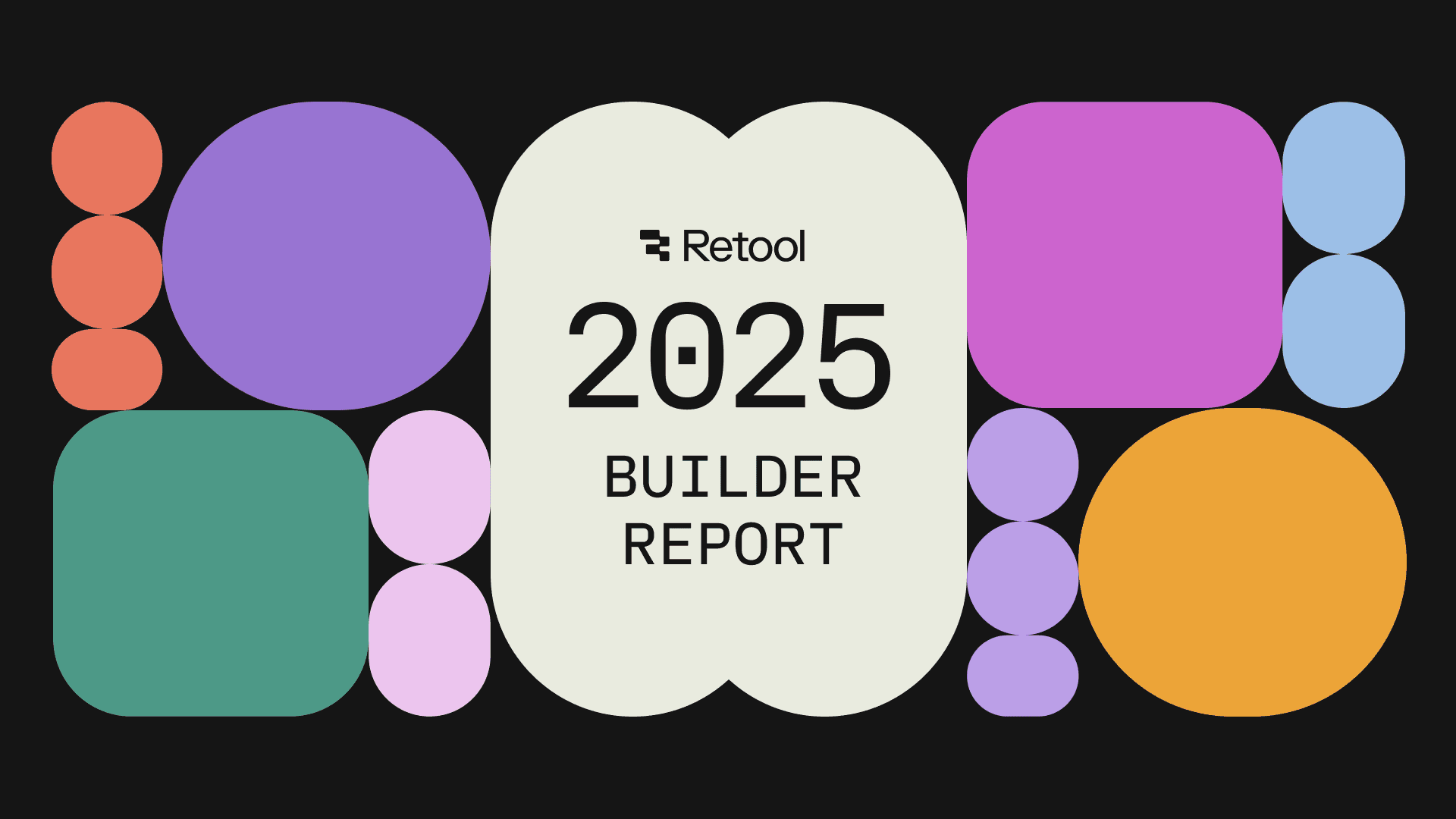The lights came up at SFJAZZ on October 7 as hundreds of builders—engineers, analysts, ops leaders—filled the seats. They came from Stripe, Uber, Komatsu, and so many other companies where they're building the software that makes business actually work.

This was Retool’s first Summit, and it really felt like a moment. Our CEO, David Hsu, opened the day announcing Retool as the world’s first enterprise AppGen platform. More people can build now, and they can do it much faster than before.
Throughout the day, we heard from customers using Retool to build transformative solutions and saw demos that preview the future of software. Four themes kept surfacing:
- The gap between prototype and production
- How to scale AI safely across an enterprise
- What happens when more people can build
- Where the boundary between human and AI actually belongs
Here are the best insights we got from a truly monumental day. Couldn’t attend in person? Missed the livestream? Catch all of the sessions in the Video Hub.
With AI, anyone can generate a prototype in seconds. But those prototypes don’t connect to real data, don’t understand your security policies, and don’t use your shared components. CEO David Hsu’s keynote launched a new era for Retool: the age of enterprise AppGen.
“What generative AI is bad at, Retool is really good at,”
—David Hsu, CEO at Retool
The bar to prototype has dropped to zero. The bar to ship hasn’t moved. That gap is where real value gets lost.
Retool’s enterprise AppGen platform is anchored by a new capability: Assist. It lets you generate production-ready apps with natural language—but unlike other AI code generators, what you get isn’t a toy. Retool apps are:
- Built on your data: connect directly to your production databases and APIs, understanding your actual schemas—customers, orders, inventory—so apps are relevant from the first prompt.
- In your cloud: whether multi-tenant or self-hosted in your VPC, your data never leaves your environment.
- Secure by default: every generated app automatically inherits your SSO, RBAC, and audit logs.
The deeper promise is faster development and an expanded bench of builders. For the first time, domain experts in ops, finance, and support can turn their ideas directly into production-grade software on the same platform engineers use to create trusted building blocks and guardrails.
Later in the day, Retool Product Marketing leaders Sean Allen and Mads Clark walked through the new AppGen capabilities, including Assist.
David established that prototypes are worthless if they can’t become production software. Retool’s Head of Product Abhishek Gupta explained that the last mile of software production—connecting to real data, inheriting security policies, fitting into existing systems—is where most AI-generated apps die.

He presented a comprehensive roadmap that tackles every part of this problem in Retool: build with AI, scale with consistency, deploy with confidence, and orchestrate intelligent processes.
Assist is now available for self-hosted environments, meaning you can generate production-ready apps with natural language directly on your data, in your cloud. Instead of generating disposable demos, you can scaffolding real applications using your actual Postgres schemas, Salesforce objects, and API integrations.
You can start with a prompt, upload a Figma file, or drop in a spreadsheet. And because it’s multimodal, you’re not locked into chat. You can point to components, switch to the visual canvas, or drop into code whenever that's most efficient.
When everyone can suddenly build, the real innovation is in preventing unmanageable chaos.
Three new capabilities will transform individual work into institutional knowledge:
Reusable functions let you define complex backend logic once and use it everywhere—across apps, workflows, and agents. They run server-side for better performance and security. Build it once, and anyone (or any AI) can import and use it.
Libraries store all of Retool’s primitives—components, modules, workflows, agents, functions—as versioned, permissioned building blocks. Need something your team has already built? Just ask Retool to import it.
Semantic objects let platform teams define business concepts once—“Customer,” “Order,” “Employee”—complete with data sources, logic, and permissions. Then any builder works with these concepts instead of raw queries. An HR app automatically shows different data based on who’s viewing it: compensation data for HR leads, team performance for managers, personal info for employees. Same app, same object, but governance is built in.
The next wave of deployment capabilities will help teams ensure production quality without slowing them down.
- Expert agents run in the background to optimize performance, identify security vulnerabilities, and debug issues—explaining their changes so your team learns.
- Performance agents will identify optimization opportunities while you build and explain what it does when it finds improvements.
- Security agents will check for standards, vulnerabilities, and loopholes, then fix them automatically.
- Debugging agents will message you when it reviews queries and catches issues before they become problems.
Native testing turns manual walkthroughs into automated tests. Click through your app once, and Retool captures requests, mocks data, and generates assertions automatically.
Self-hosted, Retool-managed deployment (now in GA) gives you control of your AWS environment with the convenience of Retool handling scaling and upgrades.
Individual apps solve specific problems, but the real transformation happens when you connect them into intelligent business processes that run autonomously.
Workflows is the nervous system that connects the apps in your business. It’s the visual automation engine that moves data between systems, triggering actions, and orchestrating logic across your entire stack. It shares the same foundation as your apps: the same data connections, governance model, and security controls. Every workflow is enterprise-ready by default.
Over 10 million workflows run on Retool every day at production scale. And now, with reusable functions, semantic objects, and AI capabilities integrated throughout the platform, workflows can leverage the same institutional knowledge and governance as your apps.
Burger Ebersohn, Global Partner Engineering Lead at Uber, took the stage to share how his team uses Retool to power global integrations that handle millions of transactions with zero margin for error.

He shared that the biggest operational improvements often come from solving tiny, specific problems with data.
One example: couriers waiting too long at restaurants. The solution was as simple as small partner plugins that made targeted API calls and updated timestamps at the transaction level. This small fix meant faster courier times and measurable dollar impact across the system.
Uber has built dozens of these unexpected plugins with Retool, each one addressing a minuscule friction point that compounds into significant operational gains at scale.
“Software doesn’t look like software anymore,” Abhishek said, introducing Eric Cheng, Enterprise Architect at Komatsu.

Facing mounting operational pressure, Komatsu built a proof-of-concept for autonomous agents in a few weeks. A few months later, the team entered—and won—the company’s global hackathon.
Now, Eric’s team is putting agentic customer care into production. Phase 1 launches soon, giving frontline staff a complete customer and machine view that cuts insight delivery time dramatically. By year-end, they plan to deploy fully autonomous agents.
The vision: human-like work at inhuman scale, with the guardrails that make it safe for production.
One of the day’s more provocative takes came from Kli Pappas, Head of AI at Colgate-Palmolive. In a conversation with Elizabeth Ray, Retool’s Head of Technical Account Management, he argued that democratization isn’t something to fear when it comes to expanding who can build.

With 750 million LLM users globally, organizations can’t control how everyone’s engaging with AI. People are already bringing their own tools. Democratization is happening, so businesses need to be able to do it safely.
“People will take the task that they have and build an automation. It makes them able to do the things that they do faster. But if you work in a team, and your task is now 10x faster and you hand it off to a person… and it sits in their inbox queue for two weeks… you haven’t actually solved a company problem,” Pappas said. “It is critically important for everyone to be engaged.”
Colgate-Palmolive built an AI hub to empower more users across the organization. The key was combining top-down training with peer advocates.
“Some process transformation… needs to happen from the top down, but some of it needs to happen from the bottom up.”
—Kli Pappas, Head of AI, Colgate-Palmolive
When evaluating an AppGen platform, certain features were non-negotiable: role-based access control, secret management, and templates with repeatability that could scale to thousands of users. To make democratization possible, enterprise governance was a hard and fast requirement.
It may be the end of programming as we know it, but developers feel fine. In a session on next-gen builders, Todd Paoletti, Product Marketing Manager, and Gabriella Angiolillo, AI Product Management Lead, laid out a new operating model: the teams closest to business problems will own building solutions, while developers will own the system that makes that possible.

When customers heard “more builders,” they needed five main things to empower them and keep chaos at bay:
- Data access: production data could be changed without someone knowing, and queries could look plausible, but actually be wrong.
- Reusability: making it easy for builders to reuse parts of the system to avoid recreating code every time.
- Consistency: keeping brand standards and app standards (buttons in different places, slightly different usage patterns)
- Trust: if apps are created quickly and don’t look polished or official, people might not really trust and use them.
- Safe editing: when a new population can edit apps you’ve perfected, errors can add up.
Governance-first architecture makes guardrails native to the platform. Platform engineers define the lanes—pre-approved data sources, reusable libraries, enforced design standards. Pro developers build complex infrastructure. Tomorrow’s builders compose solutions within those lanes.
The developer’s job shifts from writing every line to architecting the system that enables others to build safely. More builders, less chaos. Speed with structure.
Our customers and power users are evolving along a clear maturity curve—going from simple genAI experiments to agentic workflows to fully autonomous agents. But how much control do you delegate to AI, and how much stays with humans?
Paco Viñoly, Head of Design at Retool, argued that the line between human and AI collaboration must shift based on context, risk, and capability. What worked last quarter might be safely automated today. What’s automated now might need human oversight tomorrow when stakes change.
“Humans don’t disappear, they become first-class participants.”
—Paco Vinoly, Head of Design, Retool
Once customers started building with Agents, three patterns emerged:
- Tools: custom workflows for unique business processes
- Guardrails: constraints keeping agents within safe bounds
- Workarounds: clever prompting and fallbacks to handle AI’s quirks
These patterns reveal how real AI systems get hardened for production—not through perfect models, but through thoughtful system design.
The breakthrough comes through orchestration: building autonomous systems on human rails. Workflows provide deterministic execution. Agents add adaptive reasoning. Humans make high-stakes calls requiring judgment.
Automation is the AI buzzword, but it’s not the future. Perfect collaboration—machines for scale, humans for judgment, and a continuous feedback loop—will be what compounds value in the agent age.
The day closed with a fireside chat between David and Patrick Collison, cofounder and CEO of Stripe on everything ranging from the practical to the philosophical.
Patrick shared that Stripe recently added a “fix it” button to their bug tracker—powered by what they call “minions,” fully orchestrated development environments in the cloud.

Click the button, and a minion attempts to fix the bug autonomously. During a recent fix-it week, 30% of bugs were resolved by minions. Two weeks ago, 5% of all pull requests at Stripe were generated without a human ever logging into the dev box. Humans still review and approve, but the automation is real.
Patrick also shared that Stripe’s agent builder framework didn’t come from an internal AI lab. It came from the financial operations team.
“If people closer to the work build superior tools, it’ll improve not only that domain but across Stripe more broadly.”
—Patrick Collison, CEO, Stripe
When Gabi Swain, Solutions Designer at January Digital, saw the AppGen announcement at Summit, she immediately Slacked a colleague and asked them to try the new functionality.
“I think the exact quote from him was, ‘oh my god, this is excellent,’” she said.

James Gardner, a software engineer at Nuvo, has already put AppGen to work building apps that integrate with multiple systems, looking up customer profiles and linking businesses across different platforms. “It really speeds up how we can iterate on ideas and deploy applications more quickly,” he said.
Swain sees AppGen as a way to empower her small team to work more effectively. “They’re in the wild west doing their best with what they have,” she explained. “I’m really excited that Retool will become that accessible tool for them so we can keep them corralled in one spot and have a platform that builds on itself instead of a bunch of disparate tools.”
The sentiment echoed throughout the venue: builders finally have a platform that matches the speed of their ideas, and is serious enough for the enterprise.
Another builder, Brad Mathews, put it this way: “Vibe coding is if you want Flappy Bird. This might finally allow real, useful applications that people with limited technical capability could actually build.”
For years, the people closest to business challenges—the analysts who see the broken workflows, the ops leads who know what’s slow, the support managers who hear customer pain daily—have been stuck waiting for engineering resources that never come.
But not anymore. The infrastructure exists now to let anyone build safely. AI that generates production-ready apps on real data. Governance that scales consistency instead of creating chaos. Systems where humans and AI work together instead of competing. Tomorrow’s builders aren’t hypothetical. They’re already here, sitting in finance and operations and support teams across every organization. They just needed the right platform, and now it’s here.
Reader




